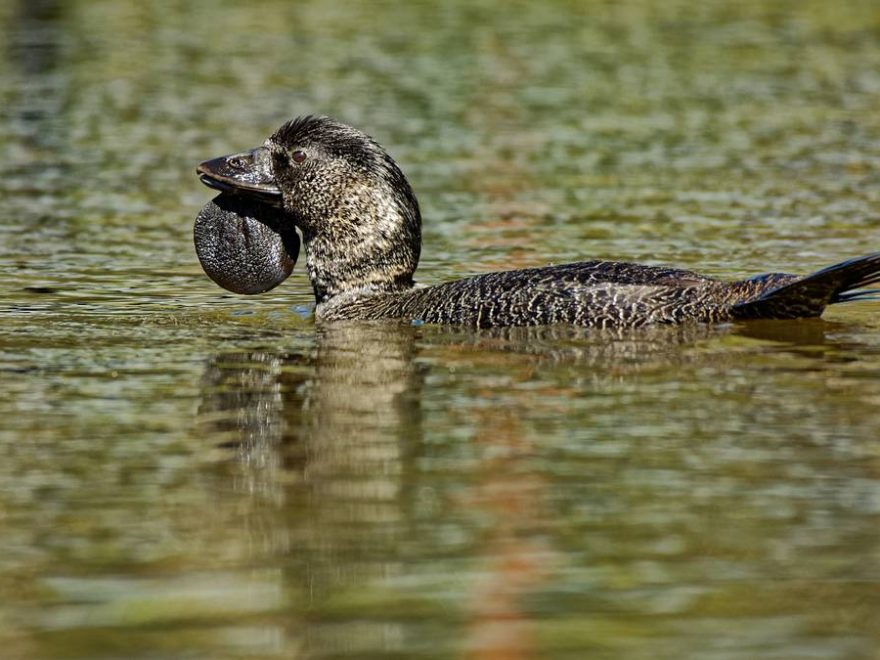Ducks usually confine themselves to quacks when communicating. However, one Australian fowl has developed a more unusual call, being known to exclaim: “You bloody fool!”
Ripper the musk duck was hand-reared by humans at Tidbinbilla Nature Reserve, located about 30 miles southwest of Canberra.
In the wild, musk ducks live in large groups and males learn the species’ characteristic high-pitched whistles from older flock members.
But without these influences, Ripper replicated the human-made sounds it heard in its formative weeks, which included doors slamming, humans coughing and speech.
It also learned to imitate its caretaker’s frequent cries of “You bloody fool!”
Ripper’s remarkable talent was first noted almost 40 years ago, but a lack of evidence and the disbelief of experts meant it was never published in a journal or widely accepted.
However, the claims have recently been re-examined by Prof Carel ten Cate, an animal behaviour expert at the University of Leiden, and the recordings authenticated.
“When I first heard these stories, I thought, ‘Oh this must be a really good joke’,” he told New Scientist magazine.
“But actually, they come from respected scientists and birdkeepers, and the reports are very reliable. Apparently, these ducks are learning something about vocalisations starting at a very young age.”
While the identity of the people who reared Ripper are unknown – all documents pertaining to the nature reserve were destroyed in bushfires in 2003 – one scientist did investigate the claims at the time.
Peter Fullagar, now retired, visited Ripper in the late Eighties and published the new paper in the journal Philosophical Transactions of the Royal Society B with Prof ten Cate.
“The recordings of Ripper were made using a Sony Walkman Professional cassette recorder and a Sennheiser MKH816 microphone on July 19 and 26, 1987, at which time Ripper was four years old,” the researchers write in the paper.
“It was recorded when Ripper was on the inside and up against the wire fence, with the microphone alongside at less than a metre distance much of the time.”
Dr Fullagar deliberately got very close to Ripper in order to provoke a response from the bird as they are aggressive to humans and this was “the best way to enrage [Ripper] into display”.
“Ripper would come up onto the narrow bank on the inside of the fence and scramble along ‘attacking’ anyone on the outside,” the study said.
“He called repeatedly, then dashed about on the small patch of water within the pen splashing water everywhere. The vocalisation is most likely an imitation of a phrase he heard repeatedly from his caretaker, but it is not known at which age he was exposed to it.”
Ripper’s unique skill is the only recorded instance of a talking duck, but Dr Fullagar also had recordings of another bird making bizarre noises in 2000.
This male had distorted whistles and also produced quacks, a noise not normally made by the musk ducks.
The findings are further backed up by claims from two other people who contacted Prof ten Cate about their own experiences hearing bizarre vocalisations coming from musk ducks.
Bill Makins wrote to the researchers about his experience in Pensthorpe, Norfolk, with another male.
“The male was a wonderful mimic when he was quite young,” he told the academics. “You could hear a lot of coughing and a snorting pony which lived next door to him. He even tried an unpronounceable ‘hello’ to the gardener.”
Mike Lubbock, another bird expert, informed the team of a male musk duck raised at Slimbridge Wildfowl Trust in Gloucestershire, which was at least two years of age when it was observed to produce an imitation of the characteristic cough of its bird keeper and a squeak of a turnstile.
However, the British musk ducks have not been recorded and are therefore unverified.
Ripper’s achievements expand the list of species that are already known to be able to mimic human language, which includes elephants, whales, seals and parrots.
Source: Read Full Article
